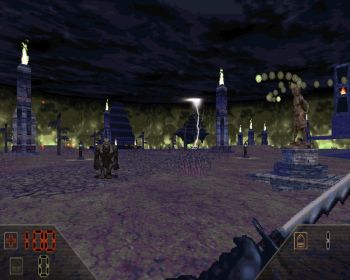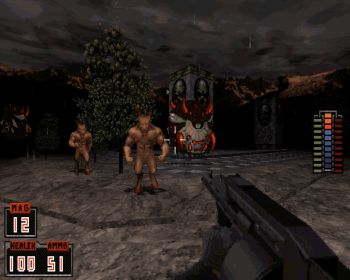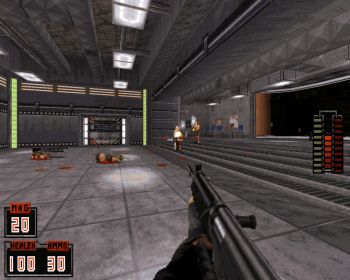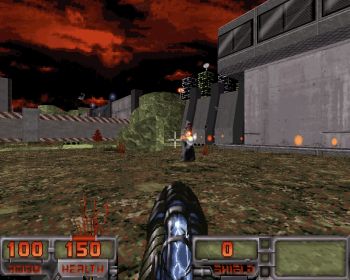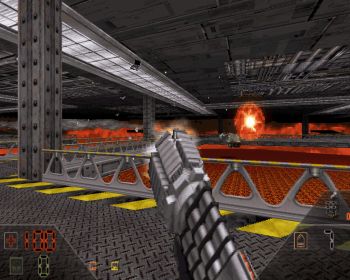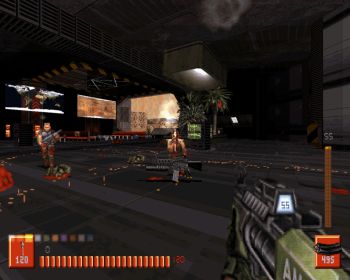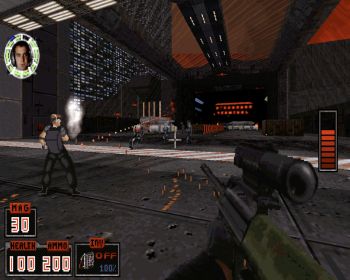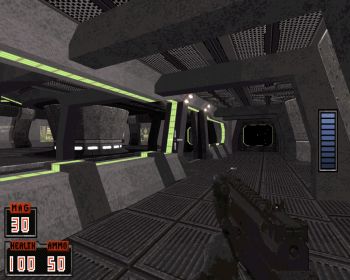The AMC TC Episode 2 by the AMC Community Note: In addition to designing one map for this TC, I tested it many times so take the objectivity of this review with a grain on salt. The mod is standalone, i.e., Duke3D is not required.|
The world is on the brink again with mysterious and diverse forces threatening it from all sides.
Only the AMC squad can muster the resources and effort required to thwart the bad guys' evil schemes.
The second episode expands the storyline established in the first and throws a few new
characters into the mix, most notably the playable character Micky C, whose real-life counterpart carried a lot
of the new episode's workload.
For anyone used to the way Duke3D functions, the mod (or, rather, a game) may be a bit of a cultural shock at first. There are a gazillion new features, even when compared to the first episode. The level-select interface is different; you return to the base after almost every mission, the missions are selected from a world-map (that encompasses several solar systems) kind of screen and they can be replayed. It's not quite perfect yet but a step in the right direction. As a first order of business new players should turn off the autoaim function (unless it already is off), which doesn't fit the TC at all; headshots are extremely important when facing armored enemies of which there are many. Take the tutorial and then dive into the game expecting something totally different and eclectic.
The second episode begins like the first one, with a map that honors the classic Duke Nukem 3D maps. City Under Siege may feel a bit tough at first but it familiarizes you to the game's new features, as if through a baptism of fire. Straightforward action is interrupted every now and then in refreshing ways; in addition to getting shrunk for a while à la Duke Nukem Forever, you get to drive and fly some vehicles. After this you're off to eastern Asia. In the following five-map segment your character is dropped in the middle of a Shadow Warrior universe. In the first map, Big Trouble in China, the emphasis is on entertaining and high-paced gunplay. The second one, The Wharf, is a more atmospheric walk through a fishing wharf. The third map, Island Facility, is a hi-tech base off the coast of Hong Kong. The map has some memorable moments such as a tank ride and a scene where an underwater base gets flooded but overall this one is among my least favorites in the episode, mostly due to its expansive layout and all the legwork involved. Tower of Life takes a more modest approach to scale, confining the player within the walls of an old monastery. After all the big maps that preceded it, this confinement felt oddly liberating, and the map ended up being one of my favorites. The following Shadow Realm couldn't be more different with its large scale, Conceptual Grandness and the introduction of the sword. The map looks amazing and all the swordplay felt refreshing (even if the sword can't really do much at the moment). Of course, with scale comes a bit of tedium in the form of having to walk long distances but at least you have some great visuals to look at while doing so. Also notice to keep your eyes open in the first two China maps; both have secret items that are necessary to unlock two secret missions, the Offshore Oilrig and the Hidden Pagoda; finishing them both yields rewards although their importance remained rather elusive. Overall this extended opening segment is a well-placed, if slightly too long, introduction to the episode. The authors have done an incredible job at capturing the looks and gameplay (and expanded on them) of Shadow Warrior, which still ranks as one of my favorite '90s shooters.
After this lengthy opener, what follows is a bunch of character-specific missions and optional side missions. Ghost Ship is a two-parter by Micky C. It's a curious mix of Sonic's "Flying Fortress Cliche" and Event Horizon. In that, it's a bit schizophrenic about whether it wants to be a spooky or an action-oriented map, leaning heavily toward the latter. The map's got a good sense of progression with Micky (the character) trying to find his way from the bowels of the ship to its deck. Micky C's skills are at their best here and he goes a long way (with the help of TROR) to give the impression that you're investigating an actual, flying ghost ship, but the map isn't the easiest to navigate due to the sheer amount of locations you may visit. Loke's Far-Mountain Reaches is another two-parter (or three, if you manage to find the secret map). It's also one of those few maps where the player seems to grow stronger the further he gets, starting with almost nothing against a relatively heavy opposition but ending up killing everything in sight with ease. Story is almost an afterthought here with focus being on ultra-detailed but slightly generic environments and straightforward action with the author making the most out of James's (the character you're stuck with) selection of military-type weapons. Energeia is my contribution to the game. In the map you (that's me!) investigate a power plant on a Mako-rich planet. The map is definitely a post-Fate Reversal work with a much grander sense of scale than in anything I did before Fate (work on my first AMC TC map, which is in the first episode, began before Fate Reversal, hence its much smaller scale).
In addition to these non-optional missions, there are several optional missions. Train on Xuglop is a short but fun train-ride (and also at the moment the sole justification for the existence of the New LA hub map). Zeta Base is a massive map with a Martian hub-style base (divided into two floors) as its setting. Of all the maps in the game Zeta Base has the most oldskool gameplay with the player bouncing around the map in search of key cards and buttons. There is a lot of potential to get lost but overall the challenge is fair so long as you pay attention to signs that mark closed off areas and use the automap to navigate. The map has a soothing atmosphere thanks to its steady (at least until the last ten minutes or so) gameplay and a few well-picked music tracks. It may feel lacking in terms of plot development but the base has a secret that's easy to overlook but provides clues to the great dangers ahead. Zaxtor contributed two maps: a beautiful and thick jungle and a hi-tech base. The Jungle Base is very familiar if you've played the last episodes of Oblivion. It involves tons of jumping from one tree branch to another. The ratio of successful jumps to initiated jumps is bound to be abysmally low so you'll be shouting expletives in no time like the Angry Video Game Nerd. Navigation is another challenge; there seems to be something everywhere you look. Thus you're absolutely required to abuse the quicksave/quickload function just in case you end up taking the wrong route, because getting back on track might otherwise take a while. There are clues, although they are not always obvious. The hi-tech base (Jungle Base Interior) is a lot easier to navigate but presents a different set of challenges (just don't fool yourself into thinking there isn't gonna be any tedious platforming). The map has an exciting underwater section, some well thought-out traps and the game's best countdown sequence. Its stand-out feature, however, is a switch from Hell that you must hit six times at specific intervals to open a door. It's a freaking frustrating puzzle but doable (I finished the map twice). Zaxtor's design philosophy seems to be that if there's a way to piss the player off, it should be done. That, or he's just extremely influenced by Nintendo/Sega era games which may not always be the best influence for first-person shooters. You may abort these missions at any time (check your PDA) but finishing them is highly rewarding. Zaxtor's maps are kinda like STALKER; you love them and hate them at the same time.
The last segment of the game takes you to Mars where the AMC squad finally gets to squad up. This final act involves multiple characters behind a common storyline. The maps, five in total, are big and varied. The first one, Arsia Mons Colony starts off with an RPG-like part where Sang investigates a colony until he's interrupted by a sudden attack that endangers the colony's civilian population. The map has a nice visual contrast between its lower, low-income parts and upper, high-income parts of the colony, but the contrast in gameplay isn't as good with the second part ranking among my least favorite moments in the game in terms of gameplay. Not only is the layout a bit too open-ended with locked doors everywhere but the open, low-visibility (a recurring problem) areas aren't really the best place to fight hitscan enemies. My character is then sent to investigate a broadcasting headquarters (Arsia Mons Broadcasting) in one of my favorite maps of the game. The map makes good use of its refreshingly non-generic setting and has a nice buildup to a boss fight (which is a bit underwhelming). In Orbital Elevator James teams up with his buddy John. This is another action-oriented map and it too is among my favorites thanks to its its relatively linear gameplay (there's some backtracking though), that you fight side by side with a buddy and, ultimately, get to play as that buddy who's got maybe the most enjoyable arsenal in the game. James and John also share some interesting dialog that seems to focus on their dick sizes (there's this Finnish saying about people talking about the things they lack...). Meanwhile Micky finds himself in Cohagen Mines where he investigating a series of mineshafts. The map starts off modestly but expands into bigger caverns, culminating in an epic cutscene. I'd say keep your eyes open for Total Recall influences, but there's no way you can miss those. In the last map, Mars Station, James finds himself facing an old threat aboard a space station. This map, architecturally the most impressive in the game, was adapted by the AMC TC team from a semi-finished map by Mike von Skellington (check the Hot Maps section) that was originally intended for the sequel to Grins of Divinity TC. After all the non-stop action of the previous maps, this map's emphasis on quiet exploration and plot development felt refreshing and fitting for a finale; I especially enjoyed the musical nod to Imagination World 2 after the (again underwhelming) boss fight.
Overall, you aren't gonna come across a more generous bunch of maps. The maps are long and diverse all the way from the narrow but extremely detailed maps (Mars Station, Loke's maps) to the less detailed but Conceptually Grand maps (The Shadow Realm, Ghost Ship). There are easy maps (Train on Xuglop) and there are frustratingly difficult maps (Zaxtor's maps). Of course, such diversity (especially the fluctuating difficulty level) can also be seen as a downside when trying to view the game as a coherent whole but at the same time the lack of strict central planning is what made the mod possible in the first place. Skyboxes often contribute a lot to a given map's visuals, and the use of sounds and assets from other games is impressive: While there may be textures all the way from Shadow Warrior to lesser known games, the authors have avoided mixing them together in ways that are not meant to be. In contrast to all these borrowed assets, the soundtrack is mostly from online music libraries rather than other games so you're not gonna run into many familiar tunes. Aside from occasional issues with volume levels (especially when dialog is involved), the soundtrack is great work all around.
The new features serve the game well for the most part but sometimes you may be a bit lost because of a feature you last came across ages ago, perhaps all the way in the first episode, or a feature that was never properly explained in the first place. An assault rifle or a shotgun may function differently across different characters which may throw the difficulty level off when playing the same map as a different character. If you have the time, starting all the way from the first episode might be a good idea as upgrades acquired there carry over to the second episode: research projects that require documents, money and tech-level points make a lot more sense when the sample of maps is large. The same could be said of many features: The "world map" is a nice idea but apart from the middle part of the game, your control over it is pretty limited. Its usefulness will probably be better revealed as the game continues to expand. Some features such as the bike (from our revolution-inducing DNF 2013) felt slightly forced.
The episode's biggest problem is its often low framerate even on modern computers. The decision to support only the software renderer seems to have been affected by two things: First, it enables the use of TROR (true room-over-room), a feature that allows (among other things) the drawing of some amazing skyboxes throughout the episode. Second, the software mode gives the game a retro look (I personally prefer smooth, filtered textures). That puts the game in a somewhat hypocritical situation whereby it boasts fully 3d, massive and architecturally complex maps but tries to render them without any help from your GPU. In the end, the game demands more from your computer than most modern games do. However, the performance is still noticeably better than in some Polymer projects such as Duke Eternity, which are best described as slide shows. You just need to be prepared to lower your resolution a bit; that way you can easily attain a tolerable, even smooth, framerate. All things considered, forcing software rendering may be justified but obviously it'd be better if we could have both TROR and fast performance; in other words, a Polymost mode that supports TROR, but that's something that's beyond the capabilities of the AMC TC team.
Conclusion: The second AMC TC episode takes the diverse ideas and themes that made the first one such a memorable experience and expands on them. The new maps are even larger and better looking (although at a noticeable cost to framerate). The storyline, which in the first episode focused mostly on backgrounds and side stories, is taken up a notch and leaves you excited for things to come. Many new features have been introduced to further distance the game from your average shooter, but some of these features are still at gestational stage, or need more content to really make them work. There's something for everyone in this game, and with more than ten hours worth of content, it should keep you entertained for a while.
Score: 9½
Download: 340 megs (also on ModDB)
Version: Standalone
Author: The AMC TC Team



